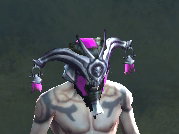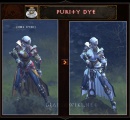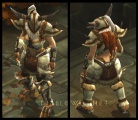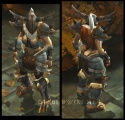Difference between revisions of "Armor Dye"
m (numerous updates and fixes) |
m (missed one item) |
||
| Line 13: | Line 13: | ||
Dyes are not found in the Diablo III [[beta]] test, but have been experimented with by players running Diablo 3 emulators, which is where most of the shots on this page originated. | Dyes are not found in the Diablo III [[beta]] test, but have been experimented with by players running Diablo 3 emulators, which is where most of the shots on this page originated. | ||
| − | Dyes are single use; when you use a color on any piece of armor, it's gone. A player will need to find multiple samples of the same dye to color all of their equipment the same hue. | + | Dyes are single use; when you use a color on any piece of armor, it's gone. A player will need to find multiple samples of the same dye to color all of their equipment the same hue. However, the exception to this rule is the [[Collector's Edition]] dyes, which are unlimited use. |
Most pieces of armor (but no weapons) can be dyed. Confirmed as dyable are [[body armor]], [[pants]], [[shoulders]], [[gloves]], [[boots]], and [[helms]], meaning that a full set of dye will be six altogether, if the player wishes to dye every piece of armor that they are able to. | Most pieces of armor (but no weapons) can be dyed. Confirmed as dyable are [[body armor]], [[pants]], [[shoulders]], [[gloves]], [[boots]], and [[helms]], meaning that a full set of dye will be six altogether, if the player wishes to dye every piece of armor that they are able to. | ||
Revision as of 14:58, 27 March 2012
Armor Dyes are a new feature in Diablo III, revealed by Jay Wilson at Gamescom, in August, 2010. [1]
There are 18 known colors of armor dye, plus two special types; dye remover and transparent dye (which makes the item not display at all). Players find or purchase dyes in the game, then use them to recolor their equipment. Dyeing (not dying) will modify the color of an item; not the whole thing, though. Just some portion, often a border or sash, or else the background of an item while the metal remains a silvery hue.
Contents
Function and Form
As far as we know, armor dyeing is purely cosmetic; there's no change to the item's stats or effectiveness. (At least not to monsters; other players might be awestruck by your colorful garb.) Though many players have suggested that higher level dyes could grant some stat bonuses or other benefits. Imagine +10 fire resistance on a special fire-red dye, for instance.
Dyes are found in various levels of rarity, and there will be some ultra-rare dyes. Dyes can not be salvaged[2] though, so dyes that are not going to be used by a player are likely to become a trade commodity.
Dyes are not found in the Diablo III beta test, but have been experimented with by players running Diablo 3 emulators, which is where most of the shots on this page originated.
Dyes are single use; when you use a color on any piece of armor, it's gone. A player will need to find multiple samples of the same dye to color all of their equipment the same hue. However, the exception to this rule is the Collector's Edition dyes, which are unlimited use.
Most pieces of armor (but no weapons) can be dyed. Confirmed as dyable are body armor, pants, shoulders, gloves, boots, and helms, meaning that a full set of dye will be six altogether, if the player wishes to dye every piece of armor that they are able to.
Dye List
There is reasonable room to speculate that some of the dyes have more function than a simple pallete shift. The description for the Abyssal dye, as an example, states "as though it were drinking in the very light that touches it," maybe hinting at some sort of extended animation or perhaps a different shader to the applied armor in question. This is just speculation, however, and remains to be seen in the final game, but it is looking unlikely.
The table below is subject to change upon release of the game, where it will be updated. The source of the dyes (whether they are all drops, quest rewards, achievement rewards, or other sources) are currently unknown.
| Dye Name | Color | Description | |
|---|---|---|---|
| |
Abyssal Dye | Black | The inky blackness seems to grow even darker when exposed to the sun, as though it were drinking in the very light that touches it. |
| |
All-Soap's Miraculous Dye Remover | Original Color | The miraculous, mystical tonic that removes stains, cures rotfoot and tastes great! It's got what plants crave! Warning: Do Not Drink. |
| |
Aquatic Dye | Light Blue | Sailors from Lut Gholein distill the waters of the Twin Seas and apply the mixture to their sails in order to blend in and avoid detection by pirates. |
| |
Autumn Dye | Orange | The monks from the Order of Yir crush the first leaves of autumn into tea, and apply it to their robes during the Ceremony of the Harvest Moon. |
| |
Cardinal Dye | Dark Red | Once reserved only for nobility, this bright red pigment is now donned by both the influential and the courageous. |
| |
Desert Dye | Light Brown | Carried by the merchant caravans of the Dry Steppes to reflect the sun and hide dust. |
| |
Elegant Dye | Fuschia | The bright colors of the Hezna flower are always a favorite amongst the fashionable elite of Caldeum. |
| |
Forester's Dye | Green | The Wardens of Duncraig wear coats of this color while patrolling the woods for poachers and wolves. |
| |
Golden Dye | Gold Yellow | Flecks of gold are melted into boiling oil to create a rare pigment used strictly by nobility. |
| |
Infernal Dye | Red | The bottle is warm to the touch, seeming to flicker with liquid fire. |
| |
Lovely Dye | Pink | Named for the beauty of Queen Asylla, who once had a thousand gowns created in this color as a gift from King Leoric. |
| |
Mariner's Dye | Blue | Officers of vessels navigating the Skovos Isles wear deep blue garments to indicate seniority. |
| |
Pale Dye | Beige | Many commoners use sunlight and minerals to bleach their garments an off-white color. |
| |
Purity Dye | White | This mysterious mixture seems to make any material it is applied to impossible to soil, swirling and coalescing like a cloud. |
| |
Ranger's Dye | Yellow Green | Hunters and bandits alike use the bark of the Gorsenna plant to blend in with the shadows of the forest. |
| |
Rogue's Dye | Dark Gray | The preferred shade of those who do not wish to be seen, especially at night. |
| |
Royal Dye | Purple | For many years this color was forbidden to all citizens of Kingsport outside the Royal Family. |
| |
Spring Dye | Light Green | Traditionally worn during the Hearth Festival in Bramwell to celebrate the first thaw of springtime. |
| |
Summer Dye | Yellow | This brightly colored dye is extracted from spices shipped from Kurast at great expense. |
| |
Tanner's Dye | Brown | Leatherworkers use a variety of oils to seal their skins with a rich, natural brown pigment. |
| |
Vanishing Dye | Invisible | Causes materials to vanish before your very eyes! Be sure not to apply this to your undergarments. |
| |
Winter Dye | Gray | Jars of crushed Veilwood petals are buried in the snow throughout the winter to create this popular hue. |
| |
Bottled Cloud (Exclusive collector edition dye) |
Cloudy White | The gentle wind of the heavens cools the air, infusing the area with a soft glow. This dye has unlimited use. |
| |
Bottled Smoke (Exclusive collector edition dye) |
Smoky Black | An eerie howl emanates from within as creeping shadows spill forth. This dye has unlimited use. |
Special Dyes
In addition to the normal dyes listed in the table below, there are two additional "dyes" which are not pigments themselves, but have special functions:
- All-Soap's Miraculous Dye Remover: Returns a single piece of armor to its original color.
- Lore: The miraculous, mystical tonic that removes stains, cures rotfoot and tastes great! It's got what plants crave!
Warning: Do Not Drink. (Note: "It's got what plants crave!" is an Easter Egg reference to the film Idiocracy.)
- Vanishing Dye: Renders a single piece of armor invisible.
- Lore: Causes materials to vanish before your very eyes! Be sure not to apply this to your undergarments.
The vanishing dye will remove the graphics for the piece of equipment in question, leaving the character in their native or "naked" state. The "naked" state is the basic look of the character before they put on any items. So it will appear that, for whichever item slot, that the character is not wearing an item, even though the stats and benefits of the item are still in effect.
The dye remover, then, is able to remove the vanishing dye, making the vanished piece of gear "reappear", and also is able to remove any pigment-based dye as well.
The short video below shows the process of vanishing and then removing the vanishing dye:
(Note that this video was shot in an emulated environment and is not necessarily indicative of how the dyes will work in the final release of the game.)
Dye Samples
The dyes correspond fairly well with the icons for each, however the tint and hue will of course change depending upon the lighting in the game and the overall palette of whichever area the players find themselves in.
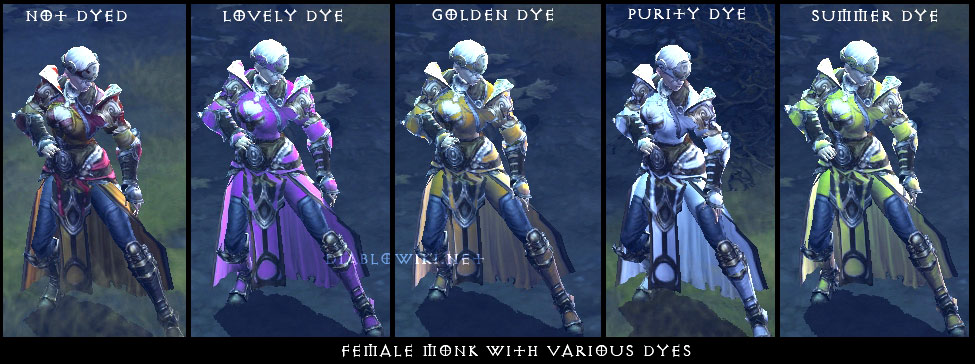
Official Comments
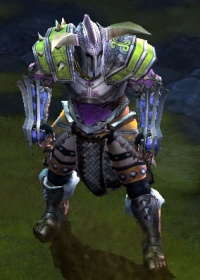
More information about how dyes will be obtained and how they will function in the game came from the Diablo 3 community manager, Bashiok, who answered some fan questions about armor dyes after they were revealed at Gamescom in August 2010.
'''Bashiok: '''There are specific slots that are able to be dyed, and it's generally the slots where dying them would actually matter (ie they have some surface area to be dyed).
'''Bashiok:''' They're technically a two color gradient, which allows us to achieve a more natural looking coloration, but for the sake of simplicity, yes they're presented as a single color.
In a fansite Q&A[3], Blizzard confirmed that there were no special effects on dyes outside of changing an item's color:
A. No they don’t have particle effects. For now they can technically only be single color gradients.
Dye Similarities and Details
The images of dyes on this page (taken from the game) were captured during the beta test, from datamined files. They may not represent what is seen in the release of the game, however, some of the dyes were seen in the live beta test and were exactly the same as the emulated dyes.
While it is possible to tell the difference between an Infernal-dyed piece and a Cardinal's dyed piece, it isn't easy to tell the difference between the two. Sometimes the only difference can be gleaned in lighting. An example of this is seen to the left, where the Demon Hunter's shoulder armor is the summer dye, while the gloves are golden dye. Another thing to note from this image is that certain armor pieces, sometimes entire sets, have native colors that cannot be changed. In the case of this Demon Hunter, who is wearing mostly plate gear, the green fabric she is wearing is part of the armor tier's theme, and the color cannot be dyed. It is permanent.
Any "groupings" of colors are going to be similar, sometimes hard to discern depending upon the lighting of the area the player is residing in at that particular time.
However, even in such a raw state, Blizzard has shown that they've stayed true to their time-honored tradition of attention to detail. In the colorful image to the right, one may notice that even the hairs on the tassels of this Monk's helmet have been dyed, tassels which, from inside of the game, are incredibly small and difficult to see. The same is true for most items. The Monk's Astral boots, for example, are natively blue with silver metal adorning the middle and sides. When the boot is dyed, the blue is dyed the color the player has chosen, but the metal is also given a slight tint towards the color of the dye to compliment the rest of the set the player is wearing, which isn't done with most items, but is needed with such a thematically strong armor piece.
Mixing and Matching
There is nothing stopping a player from choosing a different color dye for each piece of armor, besides maybe some fear of karmic retribution for all of the retinas that are sure to be burned out.
Blizzard has provided a very fair range of colors, perhaps some that players wouldn't deem "fitting" for the Diablo franchise, but options are never a bad thing for most people.
One key observation when it comes to the finality of the images on this page, and the similarity between the dyes, is that perhaps Blizzard was aiming to not have any single dye dominant amongst the playerbase. There will surely be those fringe players who enjoy entering the arena with their fully-decked Barbarian wielding a two-handed axe and a full set of pink plate armor, but the majority of players tend to gravitate towards the more popular colors in games which allow such things, which are almost always red and black.
Blizzard has covered red with two dyes, Infernal and Cardinal, but the Abyssal dye is not black. There is no real black dye. This may be intentional on Blizzard's part to keep players from all using the same dye and ending up looking identical in the end game, but only release will tell.
Until then, players may feel free to taste the rainbow.
Multi-dyed Items?
Players have often wondered if an item could be dyed in two or more colors. No, or at least the developers weren't planning to enable this, as of December 2011.[4]
Dye Visuals
Caution: These images are taken from the beta client, and were not intended to be seen by the public. They are likely to be changed by release, and are by no means final. The gallery below will eventually house a visual of each dye in the game. Not all are currently available.
References
| Items of Diablo III [e] Item Basics Normal Items Crafting Legendary Armor I Legendary Armor II Legendary Weapons 1h Legendary Weapons 2h Item Sets |
|---|







